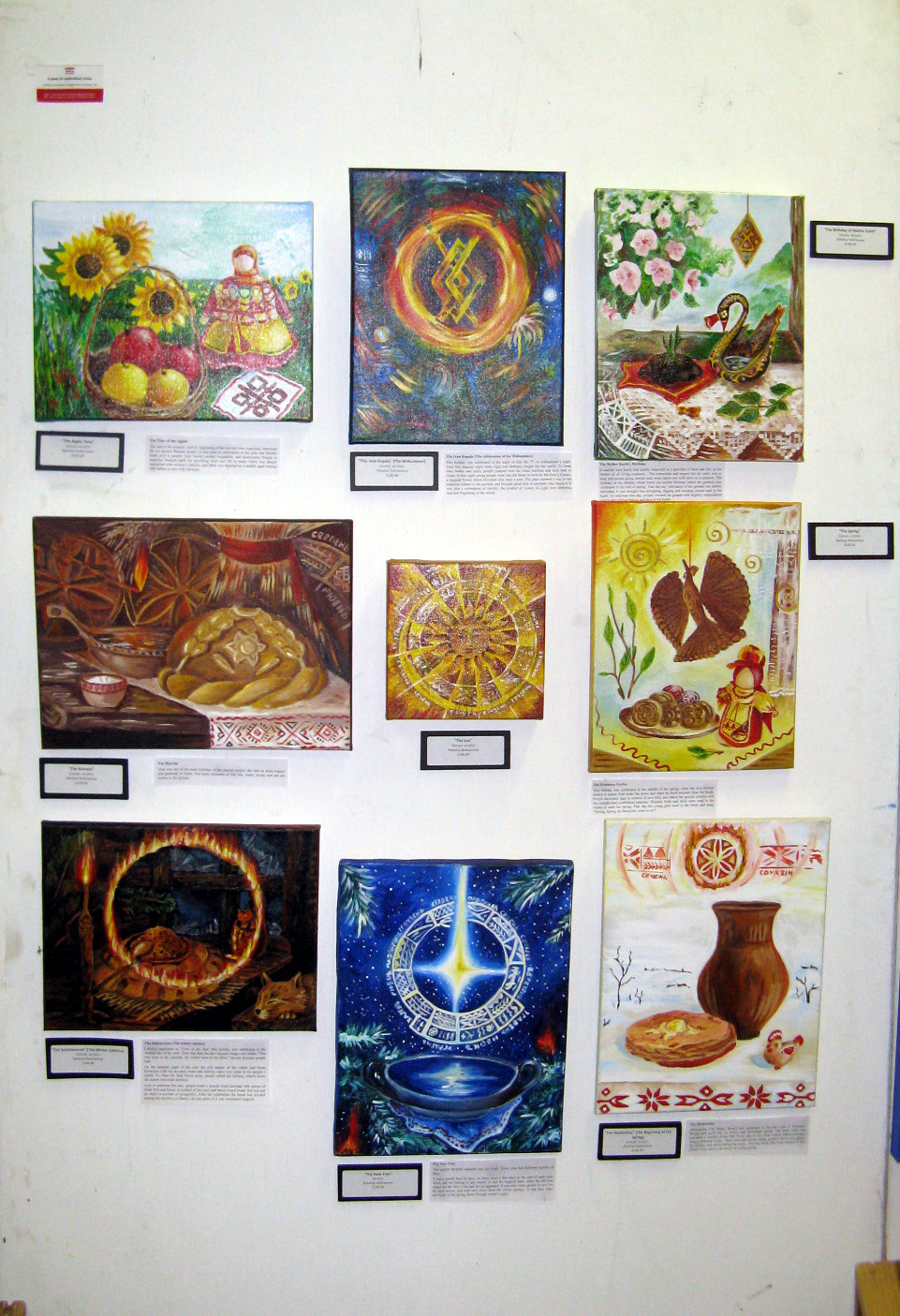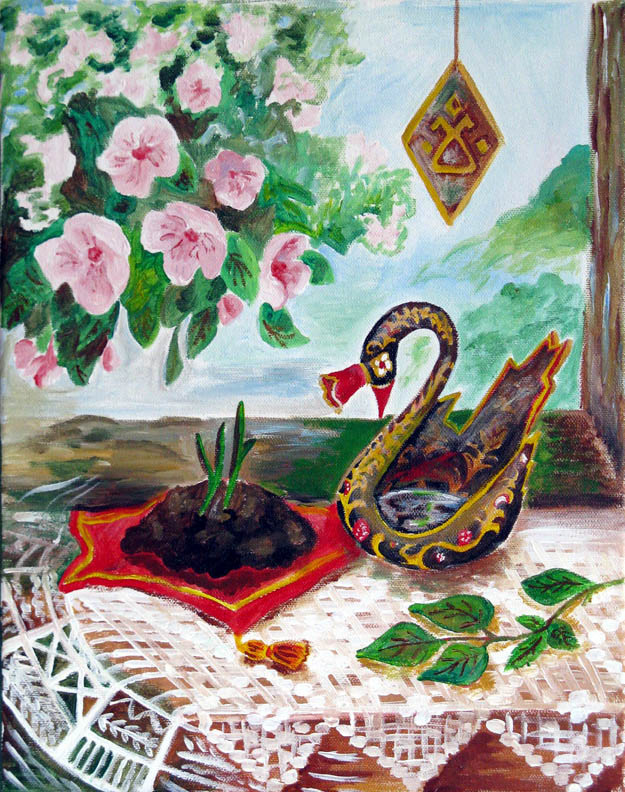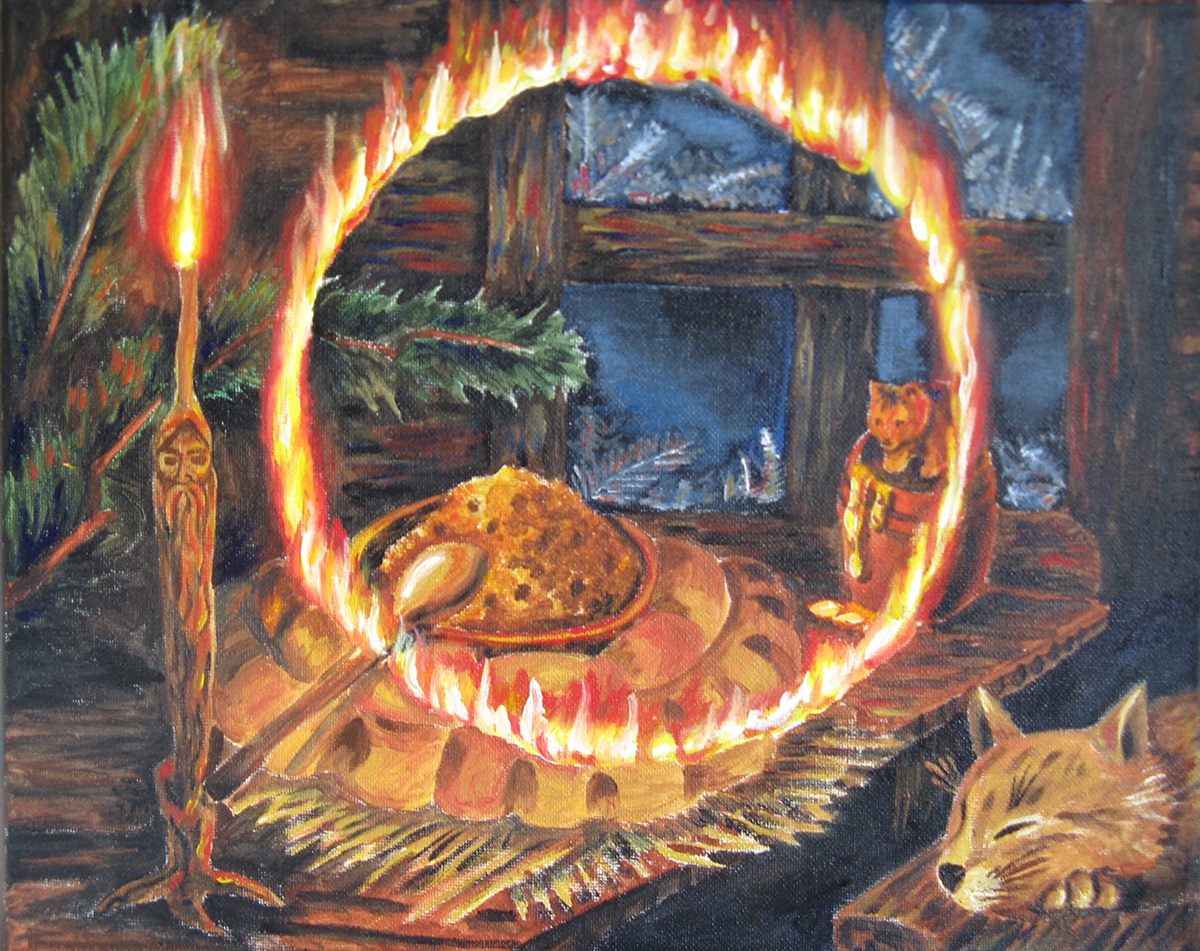
Following the Sun
I have always been fascinated with the life of our ancestors, with their wisdom and their deep connection to Nature. The old songs and customs, the traces of the ancient rites that we can see even now give me inspiration.
In this series pf pictures I show the annual circle of celebrations, following the Sun, from New year to New year.
In this series pf pictures I show the annual circle of celebrations, following the Sun, from New year to New year.

The New Year. Canvas, acrylics.
The ancient Russian calendar wasnot fixed:. Every year had different number of days.
A lunar month had 28 days, so therewere a few days in the end of each year, which did not belong to any month. Itwas the magical time, when the old year ended but the new year had not yetappeared. It was time when people lit new fire for their stoves, and took newwater from the winter springs. It was time when new hope of the spring shonethrough winter’s night.
The ancient Russian calendar wasnot fixed:. Every year had different number of days.
A lunar month had 28 days, so therewere a few days in the end of each year, which did not belong to any month. Itwas the magical time, when the old year ended but the new year had not yetappeared. It was time when people lit new fire for their stoves, and took newwater from the winter springs. It was time when new hope of the spring shonethrough winter’s night.

The Maslennitsa. Canvas, acrylics.
Maslennitsa (Butter Week) wascelebrated in the last week of February. People said good bye to winter andwelcomed spring. The main meal was pancakes, a symbol of the Sun. Every day ofthe week women baked pancakes using a different recipe. There was also horses riding, puppets shows,and games for children and adults during the week. The clay birds, like those painted in thispicture, were used in the rituals of calling spring.
Maslennitsa (Butter Week) wascelebrated in the last week of February. People said good bye to winter andwelcomed spring. The main meal was pancakes, a symbol of the Sun. Every day ofthe week women baked pancakes using a different recipe. There was also horses riding, puppets shows,and games for children and adults during the week. The clay birds, like those painted in thispicture, were used in the rituals of calling spring.

The Krasnaya Gorka. Canvas, acrylics.
This holiday was celebrated in themiddle of the spring, when the first flowers started to sprout from under thesnow, and when the birds returned from the Souht. People decorated eggs (a symbol of new life),and baked the special cookies with the complicated symbolical patterns. Woodenbirds and dolls were used in the rituals to meet the spring. That day the younggirls went to the forest and sang: “Spring, Spring the Beautiful, come to us!”
This holiday was celebrated in themiddle of the spring, when the first flowers started to sprout from under thesnow, and when the birds returned from the Souht. People decorated eggs (a symbol of new life),and baked the special cookies with the complicated symbolical patterns. Woodenbirds and dolls were used in the rituals to meet the spring. That day the younggirls went to the forest and sang: “Spring, Spring the Beautiful, come to us!”

The Mother Earth’s Birthday
In ancient time Earth was deeplyrespected as a provider of food and life, as the Mother of all livingcreatures. The connection and respectfor the earth was so deep that people going abroad took some native soil withthem as a talisman. The birthday of the Mother Moist Earth (as ancient Russiancalled the ground) was celebrated in the end of spring. That day anycultivation of the ground was strictly forbidden. It was thought thatploughing, digging and weeding caused pain to the Earth. To celebrate that day,people covered the ground with brightly embroidered towels and offered bakingand beer to the Earth.
In ancient time Earth was deeplyrespected as a provider of food and life, as the Mother of all livingcreatures. The connection and respectfor the earth was so deep that people going abroad took some native soil withthem as a talisman. The birthday of the Mother Moist Earth (as ancient Russiancalled the ground) was celebrated in the end of spring. That day anycultivation of the ground was strictly forbidden. It was thought thatploughing, digging and weeding caused pain to the Earth. To celebrate that day,people covered the ground with brightly embroidered towels and offered bakingand beer to the Earth.

The Ivan Kupala (The celebration of the Midsummer)
This holiday was celebratedin the night of July the 7 th, or midsummer’s night. That was magicalnight when light and darkness fought for the world. To clean their bodies andsouls, people jumped over the ritual bonfires and took bath in rivers. In thatnight young people went into the forest to look for the Fern’s Flower, amagical flower which bloomed only once a year. The plant showed a way to thetreasures hidden in the ground, and brought good luck to anybody who found it.It was also a celebration of fertility, the symbol of victory of Light overdarkness, and new beginning of the world.
This holiday was celebratedin the night of July the 7 th, or midsummer’s night. That was magicalnight when light and darkness fought for the world. To clean their bodies andsouls, people jumped over the ritual bonfires and took bath in rivers. In thatnight young people went into the forest to look for the Fern’s Flower, amagical flower which bloomed only once a year. The plant showed a way to thetreasures hidden in the ground, and brought good luck to anybody who found it.It was also a celebration of fertility, the symbol of victory of Light overdarkness, and new beginning of the world.

The Time ofthe Apples. Canvas, acrylics
The end of the summer, and the beginning of theharvest were especially important for the ancient Russian people. It was timeof celebration of the gifts that Mother Earth gave to people: fruit, honey,onions, vegetables, and mushrooms. People in response thanked earth forproviding food and life to them. Earth was deeply connected with women’s fertility,and often was depicted as a middle aged stout woman wearing wide skirt or as a henwith chickens.
The end of the summer, and the beginning of theharvest were especially important for the ancient Russian people. It was timeof celebration of the gifts that Mother Earth gave to people: fruit, honey,onions, vegetables, and mushrooms. People in response thanked earth forproviding food and life to them. Earth was deeply connected with women’s fertility,and often was depicted as a middle aged stout woman wearing wide skirt or as a henwith chickens.

The Harvest. Canvas, acrylics.
That was one of the main holidaysof the ancient people, the time to show respect and gratitude to Earth. Thebasic elements of life: fire, water, bread, and salt are shown in the picture.
That was one of the main holidaysof the ancient people, the time to show respect and gratitude to Earth. Thebasic elements of life: fire, water, bread, and salt are shown in the picture.

The Solntsevorot (The winter solistice). Canvas, acrylics.
Literallytranslated as “Turn of the Sun” this holiday was celebrated at the shortest dayof the year. After that date the days became longer and colder. “The Sun turnsto the summer, the winter turns to the frost,” ancient Russian people told.
On the shortest night of the year the evil master of thewinter and frosts Karachun with his servants, bears and wolves, came very closeto the people’s world. To chase the dark forces away, people rolled the burningwheels down the streets and made bonfires.
Also tocelebrate this day, people made a special ritual porridge with pieces of driedfruit and honey (a symbol of the Sun) and baked a round bread, that was put onstraw (a symbol of prosperity). After the celebration the bread was dividedamong the members of family; the last piece of it was considered magical.
Literallytranslated as “Turn of the Sun” this holiday was celebrated at the shortest dayof the year. After that date the days became longer and colder. “The Sun turnsto the summer, the winter turns to the frost,” ancient Russian people told.
On the shortest night of the year the evil master of thewinter and frosts Karachun with his servants, bears and wolves, came very closeto the people’s world. To chase the dark forces away, people rolled the burningwheels down the streets and made bonfires.
Also tocelebrate this day, people made a special ritual porridge with pieces of driedfruit and honey (a symbol of the Sun) and baked a round bread, that was put onstraw (a symbol of prosperity). After the celebration the bread was dividedamong the members of family; the last piece of it was considered magical.

